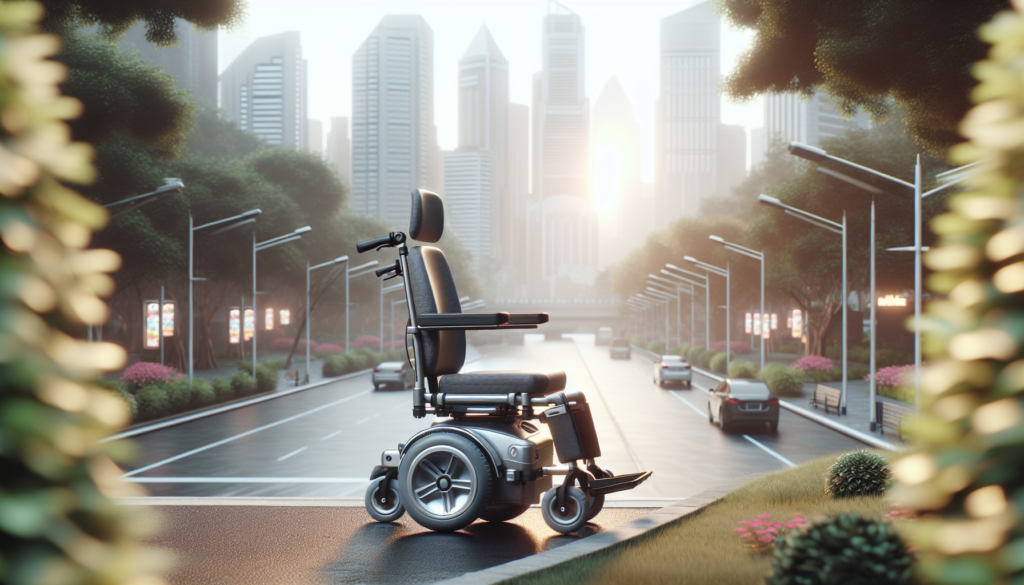When it comes to electric wheelchairs, the choice of battery type can have a significant impact on performance, range, and overall user experience. Understanding these differences is crucial for anyone considering the purchase of an electric wheelchair from EKO Life MY, as they directly relate to mobility and independence. For instance, lithium batteries, found in models like the Edegree EW6, offer benefits such as a lighter weight and quicker charging times compared to lead-acid batteries used in the Edegree EW1.

Moreover, the efficiency of these batteries influences factors like maximum load capacity, speed, and climbing ability, which are essential for users navigating various terrains. In this blog, we will delve deeper into how battery types affect electric wheelchairs, helping you make an informed decision tailored to your needs.
Understanding Electric Wheelchair Battery Types
Understanding the different battery types in electric wheelchairs is crucial for evaluating their performance and usability. The Edegree EW6, which operates on a lithium battery, offers a range of 10-15 km per charge with a significant reduction in weight at 14.8 kg, making it a lightweight option for users. The lithium batteries have a faster charge time of 6-8 hours, providing convenience and increased mobility. In contrast, the Edegree EW1 employs a lead-acid battery, boasting a longer range of 20 km per charge but weighs significantly more at 38 kg. While the lead-acid battery also has a charging time of 6 hours, it is typically heavier and less efficient compared to lithium batteries.
This weight difference can affect not only the ease of transport but also the handling of the wheelchair, especially for those who require assistance. Additionally, the performance capabilities of these wheelchair models vary greatly due to the different battery types. For instance, the Edegree EW6 has a maximum forward speed of 8 km/h and a climbing ability of less than 10°, while the EW1, despite being heavier, can tackle inclines of 13° with a lower speed of 6 km/h. Hence, users must consider their mobility requirements and terrain challenges when choosing between battery types. Understanding these factors will help users select the most suitable electric wheelchair for their individual needs.
Comparing Lithium vs Lead-Acid Batteries
When comparing electric wheelchairs, one significant factor that differentiates their performance is the type of battery used. Lithium batteries, like those found in the Edegree EW6, offer several advantages over traditional lead-acid batteries seen in models such as the Edegree EW1. Lithium batteries are lighter, weighing only 14.8kg compared to the 38kg of lead-acid batteries, making the wheelchair easier to maneuver and transport. Additionally, lithium batteries can provide a greater range per charge; the EW6 can travel between 10-15km, while the EW1 only achieves up to 20km, highlighting the improved efficiency of lithium technology despite its smaller capacity. Moreover, lithium batteries typically charge faster, offering convenience for users who need to maintain mobility throughout the day.
On the other hand, lead-acid batteries, while more affordable, come with their own set of limitations. With a maximum forward speed of 6km/h and a lower climbing ability of 13°, the EW1 is less agile than its lithium counterpart, which can reach up to 8km/h and handle slopes up to 10°. The longevity and lifecycle of a lithium battery also outshine that of a lead-acid battery, resulting in fewer replacements over time. Thus, for those seeking a more efficient, lightweight option with better performance metrics for their electric wheelchair, lithium batteries emerge as the clear winner, enhancing both mobility and independence for users.
Impact of Battery Size on Electric Wheelchair Performance
The battery size and type significantly affect the performance of electric wheelchairs, influencing factors such as range, weight, and charging efficiency. For example, the Edegree EW6 features a 24V 10AH lithium battery that offers a range of 10-15km per charge. This lightweight design, weighing only 14.8kg, makes it easier for users to handle and transport.
In contrast, the Edegree EW1 employs a 24V 10AH lead-acid battery, providing a longer range of 20km but comes with the trade-off of increased weight at 38kg. Users seeking a portable option may find the EW6 more appealing due to its lower weight and sufficient range for shorter excursions. The lithium battery’s quicker charging time of 6-8 hours also provides more convenience in comparison to the lead-acid option, which charges in about 6 hours but could still experience longer wait times if fully depleted.
Charging Times: What to Expect from Different Battery Types
When it comes to electric wheelchairs, the type of battery significantly influences the charging times experienced by users. For instance, the Edegree EW6 employs a lithium battery, which requires between 6 to 8 hours to fully charge, allowing for a range of 10-15 kilometers per charge. Meanwhile, the Edegree EW1 utilizes a lead-acid battery, which can be charged within a shorter duration of just 6 hours. Despite this advantage, the overall range of the EW1 is limited to about 20 kilometers, showcasing a trade-off between charging speed and performance.
Thus, those opting for the Edegree EW6 may appreciate the quicker recharge rate of the lead-acid variant but might find the longer range from the lithium battery more appealing for extended mobility needs. Moreover, the battery type also affects the longevity and maintenance requirements. Lithium batteries, like those in the Edegree EW6, not only charge faster but also possess a longer lifespan and are lighter, weighing in at only 14.8 kg. This lessens the overall weight of the wheelchair, making it easier to maneuver.
In contrast, the heavier 38 kg lead-acid battery in the Edegree EW1 might deter frequent transport and handling. Ultimately, understanding these differences is crucial for making informed decisions when selecting an electric wheelchair that meets user needs effectively.
Range Per Charge: How Battery Type Influences Distance

The battery type plays a crucial role in determining the range per charge for electric wheelchairs. For instance, the Edegree EW1 features a lead-acid battery, allowing it a range of up to 20km on a single charge, which is notably impressive for those requiring longer travel distances. In contrast, the Edegree EW6, which is powered by a lithium battery, offers a shorter range of 10-15km. While lithium batteries typically have advantages, such as lighter weight and faster charging times, the geography and user needs may dictate which battery type is more suitable for a given user.
Both models support a maximum load of 100kg and provide the functionality needed for users to navigate different environments effectively, yet the observed differences in range highlight the importance of battery selection in electric wheelchair design and usage optimization. When choosing an electric wheelchair, it’s essential to evaluate how battery type influences the overall distance and convenience to ensure a comfortable riding experience. The Edegree EW1’s lead-acid battery requires a shorter charging duration of 6 hours, while the EW6 takes longer, with a charging time of 6-8 hours.
Users should take into account their regular travel needs along with battery maintenance and lifespan, as these factors will ultimately affect their mobility independence. Selecting the right electric wheelchair hinges on understanding how battery differences impact both the range available and the practical use of each model in daily life.
Weight Considerations of Electric Wheelchairs with Different Batteries
When it comes to electric wheelchairs, the weight of the device plays a crucial role in usability and overall performance. Two models that highlight this variance are the Edegree EW6 and the Edegree EW1, both offering unique features influenced greatly by their battery types. The Edegree EW6, powered by a lightweight lithium battery, weighs only 14.8 kg, providing easy maneuverability and portability for users.
In contrast, the Edegree EW1, which utilizes a lead-acid battery, weighs significantly more at 38 kg. This added weight can limit mobility and convenience, particularly for individuals needing to transport their wheelchair frequently or requiring assistance for maneuverability in tight spaces. Thus, selecting an electric wheelchair with the right battery could impact not just mobility but also the user’s independence and comfort. Furthermore, the weight differences between electric wheelchairs are further compounded by their battery performance characteristics.
While the Edegree EW6 provides a decent range of 10-15 km per charge, the lighter battery allows it to maintain efficiency without being bogged down by excessive weight. The Edegree EW1 offers a longer range of 20 km but at the cost of heavier battery demands. Users must weigh these considerations when choosing an electric wheelchair, as a balanced combination of lightweight design and functional range can significantly enhance the user experience and overall satisfaction with their mobility solutions.
Max Load Capacity: The Role of Battery Type in Weight Management
The battery type in electric wheelchairs plays a vital role in determining their max load capacity, which directly impacts weight management and user experience. For example, the Edegree EW6 is equipped with a lithium battery that weighs significantly less at 14.8kg while offering a weight capacity of up to 100kg, allowing for a favorable range of portability and efficiency. Lithium batteries are known for their high energy density, which means they can provide substantial power while keeping the wheelchair lightweight. This is a crucial feature for users who need to transport their wheelchairs or maneuver in tighter spaces, as lighter models are generally easier to handle.
In contrast, the Edegree EW1 utilizes a lead-acid battery, which, despite the same max load capacity of 100kg, has a heavier weight of 38kg. This increased weight can compromise mobility and ease of use, particularly for individuals who may struggle with lifting or moving heavier equipment. Additionally, the lead-acid battery’s lower energy density results in a decreased range per charge, impacting how far a user can travel before needing to recharge. Therefore, understanding battery types is essential for potential buyers to make informed decisions that align with their weight management needs and lifestyle requirements.
Empowering Mobility: The Future of Electric Wheelchairs

In conclusion, the choice of battery type significantly impacts the performance and usability of electric wheelchairs. For instance, the Edegree EW6 utilizes a lithium battery, which provides a more efficient range per charge of 10-15 km, ensuring that users can rely on longer-lasting power for their daily journeys. On the other hand, the Edegree EW1, equipped with a lead-acid battery, offers a slightly higher range of 20 km but sacrifices weight and efficiency with its heavier design. Recognizing these differences allows consumers to make informed decisions based on their specific mobility needs and preferences.
Furthermore, understanding the battery technology behind electric wheelchairs can lead to advancements in the field, paving the way for better designs and enhanced user experiences. Innovations in battery life, recharge times, and overall efficiency will undoubtedly shape the future of mobility solutions. By embracing these variations in battery types, manufacturers can continue to empower users with improved electric wheelchairs that promise a better quality of life and greater independence.

I think the blog author did a great job in explaining the difference between lithium and lead-acid batteries for electric wheelchairs. It’s really helpful for people who are planning to get an electric wheelchair.
Thank you for your kind words, Melissa! We’re glad to hear that the blog helped clarify the differences between lithium and lead-acid batteries for electric wheelchairs. If you have any further questions or concerns, please feel free to reach out to us at [email protected] or +60 3-7890 3042. Our team is always here to help.
The analysis on Edegree EW6 and EW1 is quite interesting. It’s good to know that lithium batteries offer faster charging times which is a major perk for users with limited time.
Hi Nur Aisha, thank you for your interest in our analysis of Edegree EW6 and EW1. We’re glad you found it interesting! Yes, lithium batteries do offer faster charging times, which can be a game-changer for users with busy schedules. If you have any more questions or concerns regarding our products or services, please feel free to contact us at [email protected] or call us at +60 3-7890 3042. We’re here to help!
I never knew that the type of battery can affect the efficiency of electric wheelchairs so much. This blog post is a wake-up call for people to be more informed about their purchase decisions.
Thank you for sharing your thoughts, Samantha Chua! We’re glad that our blog post was able to educate you on the importance of battery types in electric wheelchairs. At Eko Life Malaysia, we cater to customers with various mobility needs, offering a range of eco-friendly products, including the Edegree EW6 and EW1. If you’re interested in learning more about our products or would like to get expert advice on choosing the right mobility device, please feel free to contact us at [email protected] or +60 3-7890 3042. Don’t hesitate to reach out if you have any questions or need personalized assistance!